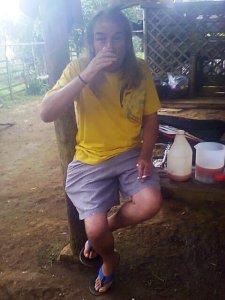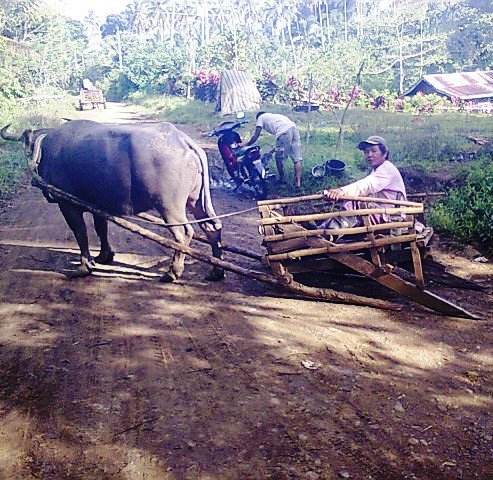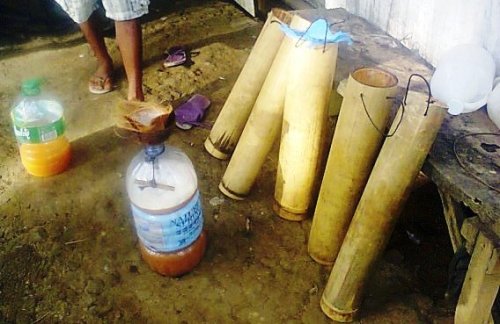It would be easy to assume this is knocking at a place that on the surface would seem to have such a heavy drinking culture but I’m not. If I was thinking overly negatively about what I witnessed, I would be a complete hypocrite as I merrily indulged in the same vices as many here in Catigan. I have witnessed a lot of drinking in my time in the Philippines generally and I make no denials that I am prone to the very same vices as those around me.
In Catigan, they can drink and drink hard. It’s hardly surprising in an isolated community with very little to do as it is in Catigan. I witnessed people drunk at 7 in the morning and just to emphasise that I’m not above such things, I would be offered my first shot by locals at that time if I was up early enough and I would often take it.
Drinking so early wasn’t general, far from, but I saw individuals who regularly have a bottle of Tanduay for breakfast and would be sat in a small group sharing a bottle of the lethal rhum and very much the worse for wear, yes even at that hour. However, it must be said that this was only a few who had such tendencies but I completely understood why and how they got into such a state.
Many people here are rooted in Catigan; in fact, they have little reason to go anywhere else and drinking was all there was to do. So whether they had a day’s work ahead of them or not, some would happily begin the day intoxicated.
Drinking to the extreme like I just described was not typical though. More typical would be people getting up, do their work and maybe by mid afternoon indulge in the local favourite of tuba (coconut wine). I confess, I was a little more typical than most. Often fuelled by boredom, I would often find myself buying a half gallon for 20 pesos, have a few glasses and sleep away the late afternoon.
Sundays were the most social time as many would have the day off and they get together at the local videoke and spend the whole day drinking. Also, drinking was done frequently in homes and outside sari sari stores. I have to admit that despite its debilitating effects, I fell into the same trap much too often. Yes, I have had many a day when I’ve drank far too much of either Tanduay rhum or tuba or even both. I won’t over indulge in the social consequences as life went on for most normally but I will say that in a place with nothing to do, it’s inevitable. Drinking was the only pastime for many.Here, I was experiencing my first taste of living among one of many of the tribes of Mindanao, the Bagobo tribe, yet I did not see anything much of the culture or learn much about the roots of these people as everything just seemed like most rural places in the Philippines. I know that some are proud of their roots and they speak in their own dialect and some express pride in their ancestry but nevertheless, I really didn’t feel I was living among a tribe; they just seemed like every day Filipinos living off the land and getting by.
Cheap and Cheerful Tuba
Tuba is a common feature of Mindanao. In fact, there are a few varieties; some fermented over a period of time but here it was fresh and was on sale in the sari sari stores within hours of being tapped from the coconut tree. It’s a cheap resource and readily available and it most definitely has a big influence on everyday life for many and during my stay, me also. So enough said about that, what I want to tell you about is the fascinating process of collecting tuba and how it is made.
It seems simple enough on the surface to produce tuba if scaling 30 ft. or more up a tree to collect it is simple. It most certainly isn’t something I could even remotely imagine myself doing. I get dizzy on a bridge and watching these guys effortlessly climb up the coconut tree had me in awe for their courage and tree climbing skill.
Climbing coconut trees is a skill many possess and I’ve even seen them do it at night holding a torch. Many do it to bring down the young green coconuts as part of their living and tuba collecting is effortless to these guys. I would have a vertigo attack looking up at them from the ground so it most definitely is not something I would consider as a white boy who has only climbed the odd apple tree as a small boy.
I was completely in the dark as to what tuba was when I first got here and foolishly believed it was made from the coconut juice from fresh young green coconuts. I was very wrong.
Tapping the Flower
 Tuba is actually made from the sap of the flower.
Tuba is actually made from the sap of the flower.
A bamboo vessel is then placed over the cut end which collects the sweet sap and that is collected often in the very early hours and taken back to the home for processing and it’s left to ferment awhile but not too long. It is then filtered and taken off to the sari sari store where it was freely available and freely drank.
Thetungog (bark of mangrove tree) is added into the bamboo tube attached to the flower in the mid afternoon and the sap is collected very early the following morning. The tungog is what gives it its kick and it certainly has a kick, even more so when its more mature but mature tuba loses its sweetness and is much nicer drank fresh as its sweeter then. As the day goes by, it deteriorates quite quickly which makes it stronger but it becomes sour. I would only drink it fresh as I didn’t enjoy it old. It was less potent when fresh but still potent enough.
It seemed different producers varied the amount of tungog they would add to the sweet sap and you soon got to know who made the nicest batch or at least one that suited your taste. Some like it sweet, some like it sour. I was most definitely a sweet man.
Health Hazard

 It was said to me on a few occasions that tuba is not good for people with high blood pressure. Well, generally throughout life, I have always failed tests, so I am particularly proud of the fact that every time I have had my blood pressure tested, I’ve come out with a good reading. After a few glasses of tuba, I would feel my blood pressure rising. I would go reddish and could be prone to the odd temper tantrum after drinking too much of it. The danger I experienced was liking the taste too much. It’s so sweet when fresh, too easy to drink and a half gallon could slip down my neck very quickly. It was also noticeable that very often on Sundays, which was the most sociable time in Catigan, fights would often break out among bickering drinkers. I also noticed that people tended to talk more shit than usual under its influence and probably myself, too. I soon learnt that the best place to indulge was at home.
It was said to me on a few occasions that tuba is not good for people with high blood pressure. Well, generally throughout life, I have always failed tests, so I am particularly proud of the fact that every time I have had my blood pressure tested, I’ve come out with a good reading. After a few glasses of tuba, I would feel my blood pressure rising. I would go reddish and could be prone to the odd temper tantrum after drinking too much of it. The danger I experienced was liking the taste too much. It’s so sweet when fresh, too easy to drink and a half gallon could slip down my neck very quickly. It was also noticeable that very often on Sundays, which was the most sociable time in Catigan, fights would often break out among bickering drinkers. I also noticed that people tended to talk more shit than usual under its influence and probably myself, too. I soon learnt that the best place to indulge was at home.
Tuba is a big part of the life here and a cheap way for people to pass the time. It may not be good for the blood pressure but locals will tell you, it’s full of vitamins. I have no idea how true that is but that would be my excuse for my excesses. Since leaving Catigan, I haven’t been anywhere yet where it is so freely available. Free shots was commonplace as its cheap and even an old kuripot (tightfisted) foreigner like me would happily share as another 20 pesos would get me another half gallon. It was also available in the sari sari at 2 pesos a glass.
 I loved tuba when fresh. I have to be honest though that I’m glad to be away from it now. I could see how easy it can be to get drunk daily with something so cheap and easily available. Mixed with Tanduay, it was lethal.
I loved tuba when fresh. I have to be honest though that I’m glad to be away from it now. I could see how easy it can be to get drunk daily with something so cheap and easily available. Mixed with Tanduay, it was lethal.
Well, I doubt I shall be returning to Catigan after this last trip as my kids have moved away from there. Probably, just as well.





